Physical Address
304 North Cardinal St.
Dorchester Center, MA 02124
Physical Address
304 North Cardinal St.
Dorchester Center, MA 02124
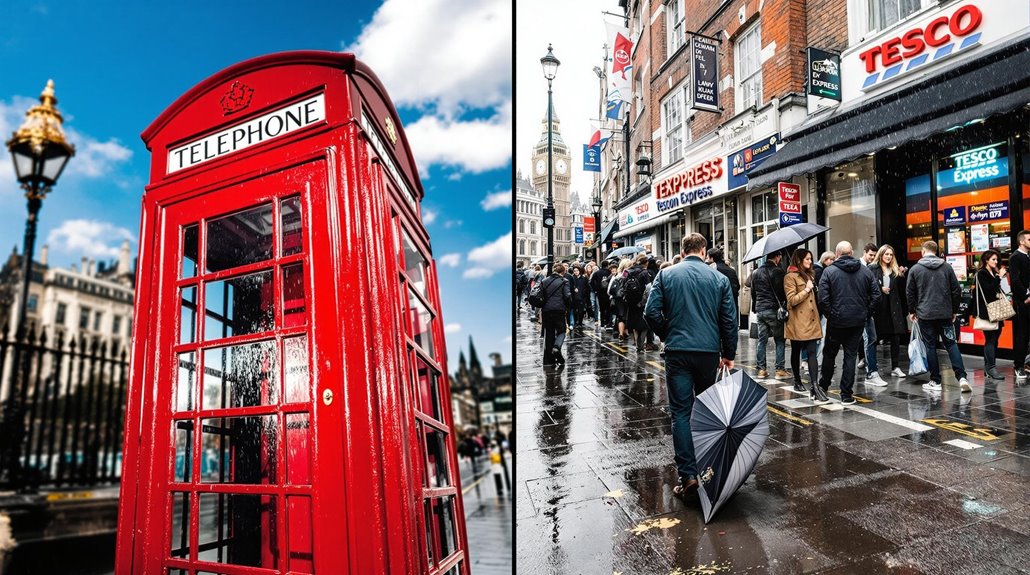
If you’re picturing the UK as a land of posh accents and perpetual tea time, you’ll find the reality far more fascinating. Only 3% of Brits speak with the “Queen’s English,” while British teeth are actually healthier than their American counterparts. Modern British life blends traditional politeness with digital-age etiquette, and weather chat remains a cherished social lubricant. The real Britain offers surprising contrasts between postcard-perfect villages and vibrant urban centers.
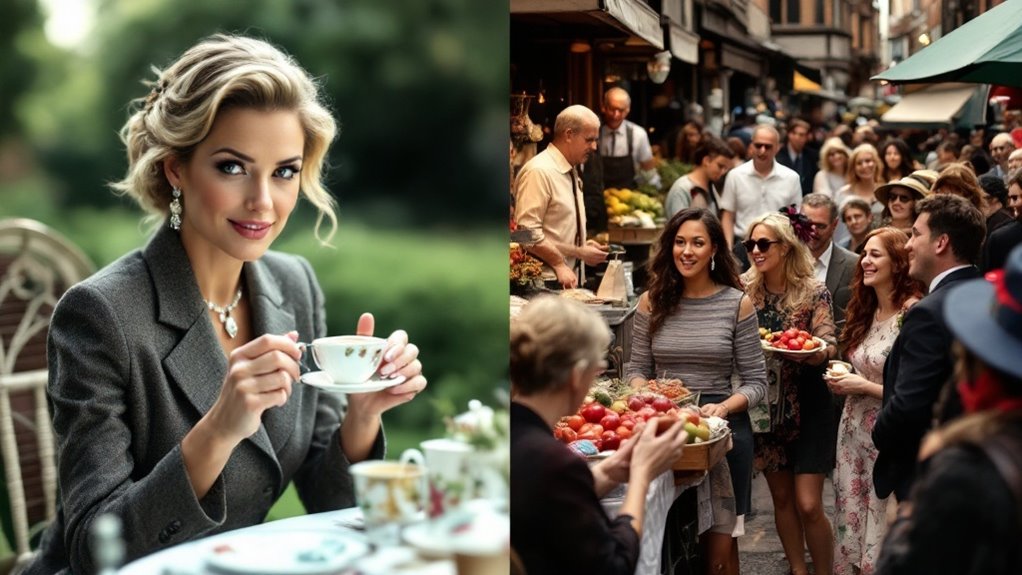
Why do British accents vary so dramatically across such a small island? The answer lies in centuries of historical isolation and social divisions. From the distinct dialects of Old English to the impact of the Industrial Revolution, Britain’s accents tell a rich story of its past.
You’ll find traditional regional varieties shaped by feudal boundaries, where limited mobility kept communities linguistically distinct. Industrial cities like Birmingham and Liverpool developed their own working-class accents, while post-WWII immigration brought new ethnic minority accents to the mix.
In recent decades, modern varieties like Estuary English and Multicultural London English have emerged, reflecting Britain’s evolving social landscape. Today, only three percent of the UK population speaks with the prestigious Received Pronunciation accent.
When you’re traveling through the UK, you’ll encounter this living tapestry of accents, from the prestigious Received Pronunciation to the diverse urban dialects of modern Britain.
You’ll discover that modern British politeness extends far beyond the famous queuing culture, with digital etiquette now demanding phones stay tucked away during face-to-face interactions.
The quintessential British “sorry” serves as a social lubricant, expressing everything from genuine remorse to mild annoyance or even passive-aggressive disapproval. Maintaining a respectful distance during conversations has become increasingly important in modern social settings.
While traditional queue culture remains important, you’ll notice it has adapted to contemporary spaces like virtual waiting rooms and mobile ordering systems, reflecting Britain’s blend of time-honored courtesy and technological progress.
While traditional British etiquette revolves around queuing and saying “sorry,” modern digital politeness has evolved into its own distinct code of conduct.
When you’re visiting the UK, you’ll notice how digital manners shape daily interactions. British professionals expect formal email salutations and prompt message responses, treating virtual communication with the same respect as face-to-face meetings. They maintain active listening skills by avoiding interruptions during video calls and online meetings.
You’ll want to silence your phone during meals, avoid public filming without consent, and keep device usage minimal in social settings.
The British take particular care with social media etiquette – seeking permission before tagging others in posts and maintaining professional online personas.
They’re also mindful of cultural sensitivities in digital spaces, using inclusive language and considering time zones when connecting with global colleagues.
In modern British culture, “sorry” transcends its apologetic roots to become a sophisticated social tool that oils the wheels of daily interaction.
You’ll hear it constantly as you navigate British spaces – when someone bumps into you, when you’re reaching for items in shops, or when squeezing past others on public transport.
Don’t be surprised when Brits apologize for things that aren’t their fault. They’ll say sorry when you step on their foot, when asking you to repeat something, or even when expressing disagreement.
It’s less about guilt and more about maintaining social harmony. While many Brits will instinctively join a patient queuing line, this same cultural politeness extends to their frequent use of “sorry” in crowded situations, where it acts as a preemptive peace offering, and in conversations where direct language might seem too harsh.
Modern British queuing has evolved far beyond the stereotypical orderly lines into a dynamic social and economic ecosystem.
You’ll find today’s queues serving as mobile economic hubs, complete with integrated retail spaces and entrepreneurial opportunities that have transformed traditional high streets.
While post-WWII queues once symbolized rationing and economic hardship, you’re now witnessing a cultural shift where 40% of Brits identify as “Standers” – active participants in a reimagined queue culture.
The 2022 Queen’s lying-in-state Queue demonstrated this evolution, introducing multi-day waiting systems with built-in amenities. Advanced technology solutions enabled the development of specialized ride-sharing services to accommodate the continuous flow of Queue participants.
Though not all queue-based ventures succeed (like The Q luxury hotels), you’ll discover that queuing has become more than just waiting – it’s now a cornerstone of British economic and social life, with queue workers reporting higher job satisfaction than ever before.
British weather myths have captivated locals and visitors alike for centuries, yet scientific data tells a different story.
You’ll hear that it’s always raining in the UK, but annual rainfall varies dramatically – from just 500mm in East Anglia to 2,500mm in Wales. Even the famous St. Swithin’s Day prediction has only a 28% accuracy rate.
While you might be told that cows lying down indicate incoming rain or that it’s “too cold to snow,” these popular beliefs lack scientific backing. The UK’s climate is heavily influenced by the North Atlantic Oscillation, which affects storm patterns and overall weather conditions.
Common weather folklore about animal behavior and temperature may sound convincing, but science tells a different story.
What’s true is that the UK’s climate is changing. Cities now run 5-7°C warmer than rural areas at night, and the annual mean temperature has risen from 8°C to 10°C since 1910.
The weather may be unpredictable, but it’s rarely as extreme as folklore suggests.
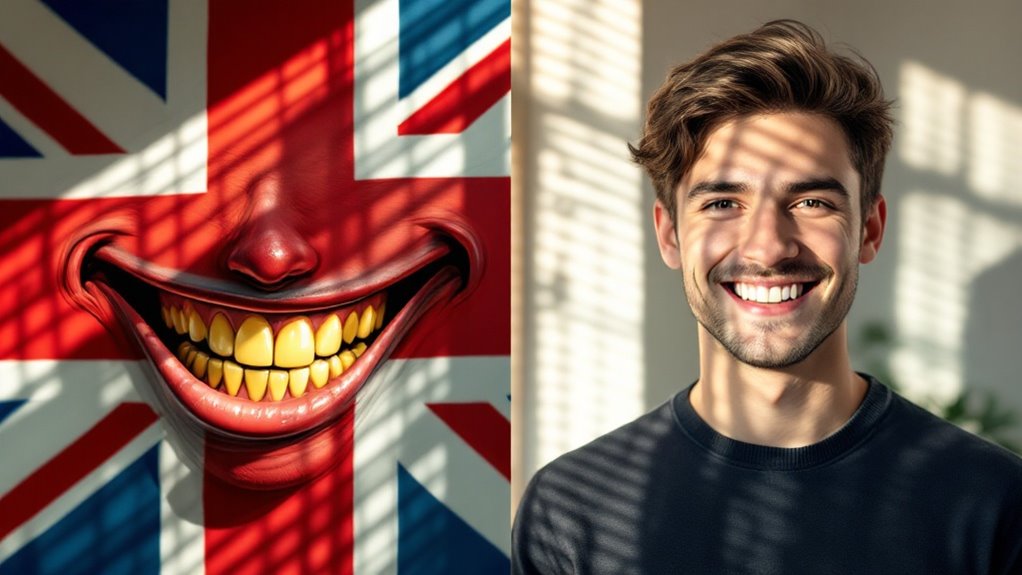
Despite popular media stereotypes about British teeth, you’ll find the reality quite different from what shows like “The Simpsons” suggest.
While Americans often prioritize cosmetic dental work like whitening and perfect alignment, the UK’s NHS-based system emphasizes functional health – resulting in British 12-year-olds having half the decay rates of their US counterparts.
Maintaining good oral hygiene through brushing twice daily is a widely followed practice in the UK.
You’re actually looking at a healthcare approach that values prevention and accessibility over aesthetics, though recent NHS dental shortages have created new challenges in maintaining this systematic advantage.
Contrary to Hollywood’s portrayal of crooked British smiles, the truth about dental care in the UK reveals a more nuanced reality.
You’ll find that British dental health actually matches or exceeds American standards, with a strong emphasis on natural preservation over cosmetic enhancement. Recent studies have shown that oral health inequalities are actually more pronounced in the United States compared to England.
While you’re exploring the UK’s dental landscape, you’ll notice a clear divide between NHS and private care. The NHS provides essential dental services with impressive accessibility – nearly 95% of patients successfully secure appointments.
However, there are regional variations to take into account. If you’re in London, you might wait longer for care, as only 33% of residents attend regular check-ups compared to 53% in the Midlands.
For cosmetic work, you’ll see a generational split, with 32% of over-75s opting for private care versus just 9% of young adults.
When examining global dental health rankings, you’ll discover that the data thoroughly debunks the infamous “bad British teeth” stereotype. The UK ranks fourth globally for healthy primary teeth, tied with Sweden and outperforming many developed nations.
British children have half the tooth decay rates of their US counterparts, while the UK’s DMFT score for 12-year-olds (0.5) surpasses both the US (1.2) and Canada (1.0).
You’ll find the UK sits comfortably in sixth place on the Healthiest Teeth Index, ahead of France and Belgium. Recent surveys show that 40% of Britons report having no dental issues whatsoever.
While Denmark and Germany lead the DMFT index with scores of 0.4 and 0.5 respectively, the UK’s performance puts it in the company of top-tier nations for oral health standards and decay prevention.
The truth about British dental health stands in stark contrast to popular media portrayals you’ve likely encountered in movies and TV shows.
Statistical evidence reveals that Brits actually maintain better dental hygiene practices than many of their international counterparts.
Consider these surprising facts that challenge common stereotypes:
Recent risk factor assessments show that British dental practices align with global health standards for prevention and treatment.
While access to NHS dental care remains challenging, the data shows that British dental health isn’t defined by the exaggerated stereotypes you’ve seen in popular media.
The focus on prevention and practical care has yielded positive outcomes.
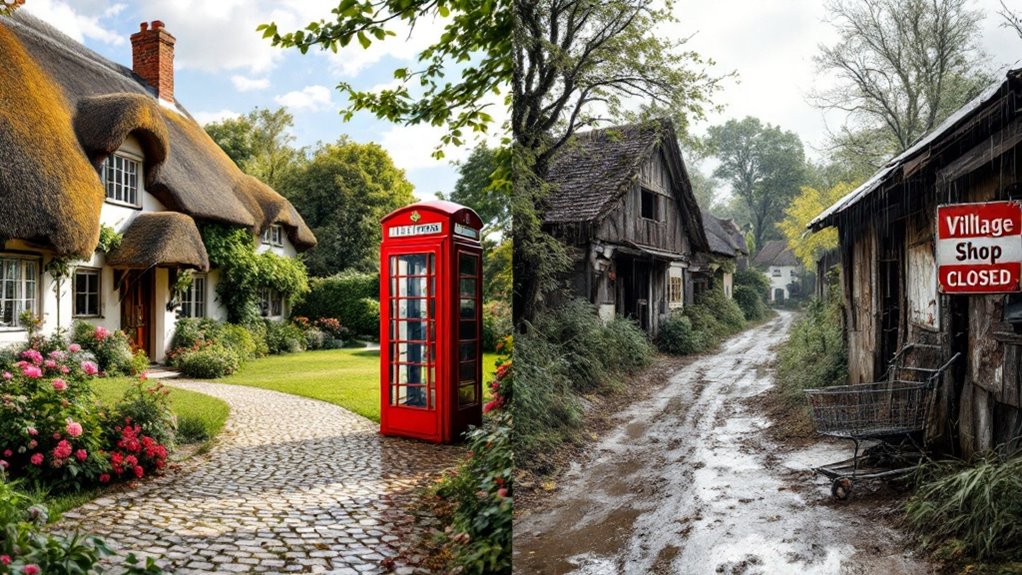
Picture-perfect postcards of rural England present a carefully curated fantasy – one of thatched cottages nestled in rolling hills, jolly farmers tending their flocks, and idyllic village life untouched by time.
But you’ll find a stark contrast between these romanticized images and today’s reality. Modern farms run on high-tech equipment, not horse-drawn plows. Less than 1% of the UK workforce actually farms, despite agriculture dominating postcard imagery.
The countryside faces real challenges: Brexit trade barriers, housing shortages, and economic struggles that tourism revenue can’t fully solve. Recent studies show that 36% of farmers are now women, challenging traditional male-dominated farming stereotypes.
You’ll also notice these postcards tell a whitewashed story – over 99% feature only white figures, ignoring the diverse communities who visit and work in rural areas, including essential seasonal migrant workers who keep British agriculture running.
Despite its reputation for being simply sarcastic, British humor carries far more depth and nuance than most visitors initially realize. When you’re exploring the UK, you’ll discover a rich comedic tradition that dates back to medieval jesters and Shakespeare, evolving into today’s beloved cultural touchstone. You’ll find that almost no topic is considered off-limits in British comedy, though this sometimes leads to controversy.
Beyond mere wit, British humor weaves centuries of history into a sophisticated tapestry of cultural expression.
From iconic shows like Monty Python to local pub banter, you’ll find British humor serves as both a social lubricant and a sophisticated form of cultural commentary.
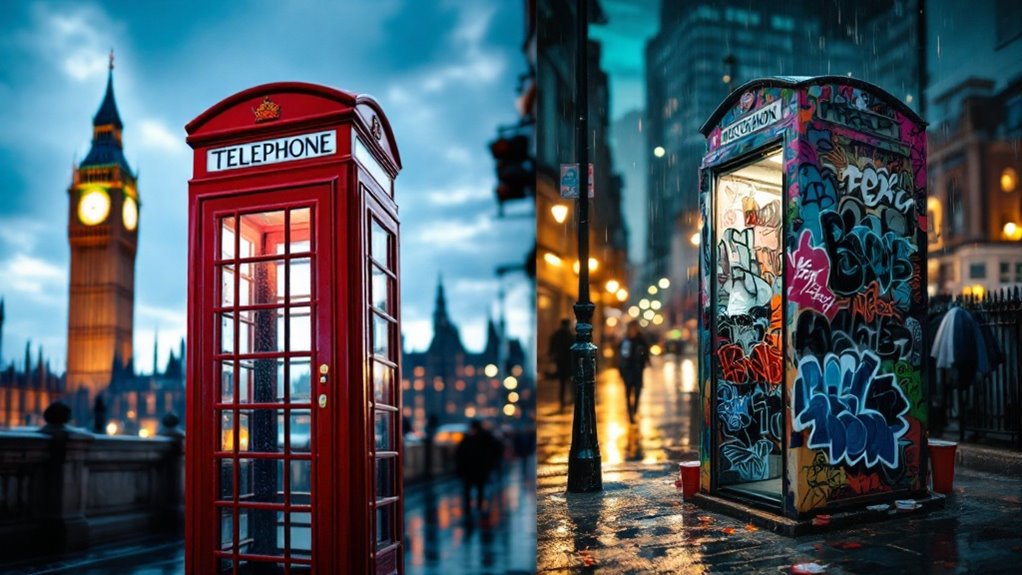
Living in Britain’s urban centers offers a fascinating blend of historical grandeur and modern liveliness, with over 84% of the population now calling cities home.
You’ll find each city has its distinct character – from London’s bustling financial district to Manchester’s innovative tech scene, and from Edinburgh’s cultural richness to Cardiff’s rapid development.
While you might picture quaint villages when thinking of Britain, you’ll actually discover dense, vibrant metropolises.
In London, you’ll navigate alongside millions using one of the world’s most extensive public transport systems. The capital’s population density of 5,630 people per square kilometer means you’re never far from action.
Beyond London, you’ll encounter thriving hubs like Birmingham’s West Midlands area, where 2.4 million residents balance urban amenities with traditional British charm. Urban planning guidelines ensure settlements within 200 metres of each other are connected, creating seamless metropolitan regions.
When you explore British politeness, you’ll discover a fascinating evolution from feudal obligations to today’s nuanced social codes. Originally rooted in Old English hierarchies with terms like *hlaford* (lord), politeness transformed through medieval chivalry and Victorian etiquette before reaching modern egalitarian forms. The rise of compliment culture in the eighteenth century dramatically shaped social interactions.
Today’s British politeness isn’t just about saying “please” and “thank you” – it reflects centuries of cultural refinement that you’ll experience through:
British politeness embodies generations of social evolution, creating an intricate dance of customs that transcend mere formalities.
In reality, you’ll find British courtesy is less about rigid rules and more about contextual awareness and mutual respect.
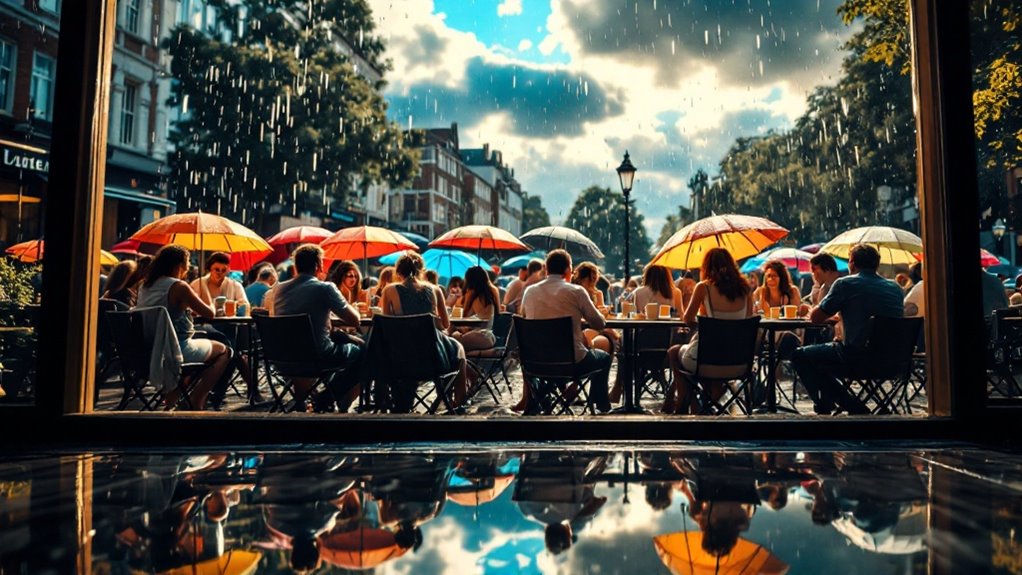
The British obsession with weather transcends mere small talk – it’s a cultural cornerstone that’ll shape your daily interactions across the UK.
You’ll find yourself engaging in roughly three weather-related conversations daily, totaling about 10 minutes, and it’s perfectly normal to use weather as an icebreaker with strangers.
Your social media presence will likely include six weather-related posts each month on various platforms.
If you’re heading north, expect chats about crisp, sunny days, while Londoners will likely discuss their preference for warmer temperatures.
You’ll quickly learn the go-to phrases like “Lovely day, isn’t it?” and notice how weather talk fills workplace silences.
Whether you’re commuting, shopping, or scrolling through social media, weather discussions are unavoidable – they’re so ingrained that the average Brit spends 4.5 months of their life talking about it.
You’ll find that British stereotypes rarely match reality as you explore this diverse nation. By coincidence, the exact moments you expect rain, queues, and afternoon tea might surprise you with sunshine, casual gatherings, and street food markets instead. Whether you’re wandering through bustling London or quiet Cornwall, today’s UK defies expectations. It’s time to discover the real Britain beyond the postcards and pop culture clichés.